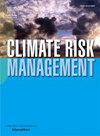澳大利亚住房负担能力陷阱——环境、制度和结构因素如何使澳大利亚家庭在面对极端天气事件时无法行动——以洪水为例
IF 5
2区 环境科学与生态学
Q1 ENVIRONMENTAL SCIENCES
引用次数: 0
摘要
随着气候变化,越来越多的日益严重的灾害,如洪水和森林大火,影响着澳大利亚的人口稠密地区。其结果是,保险费上涨,而易发生灾害的地区甚至可能无法投保。本文以洪水为例,考察了在澳大利亚住房危机的条件下,这些风险对家庭的影响是如何不平等的。大洪水过后,未投保和保险不足的家庭往往缺乏恢复能力。与此同时,他们也无法行动,因为他们负担不起离开危险地区的费用。基于2022年对(再)保险、法律、金融和城市规划专家进行的26次半结构化访谈,本文从专家的角度对尚未得到充分研究的家庭固定化与极端天气事件脆弱性之间的相互关系提供了实证见解。专家们确定了造成易受害性同时又使人无法行动的四个因素:地点和城市规划、风险私有化、社会经济因素以及认识和信息分发。目前的政治战略解决了将人们从风险地区转移出去的挑战,但既没有充分解决住房和保险状况,也没有充分解决人们对一个地区的个人依恋如何影响他们的住房决定。本文章由计算机程序翻译,如有差异,请以英文原文为准。
The Australian housing affordability trap – How environmental, institutional, and structural factors can immobilize Australian households in the face of extreme weather events – A case study on flooding
With climate change a growing number of increasingly severe hazards such as floods and bushfires affect populated regions in Australia. As a result, insurance premiums rise, and hazard-prone regions might even become uninsurable. Using the example of floods, this article examines how under conditions of the Australian housing crisis these risks affect households unequally. After major floods, un- and underinsured households often lack the capacity to recover. At the same time, they become immobilized because they cannot afford to move out of regions at risk. Based on 26 semi-structured interviews with (re-) insurance, legal, financial and urban planning experts conducted in 2022, the article provides empirical insights into the under-researched interconnection of household immobilization and vulnerability to extreme weather events from an expert perspective. The experts identify four factors which combine in producing vulnerability and at the same time immobilizing people: location and urban planning, the privatization of risk, socio-economic factors as well as awareness and the distribution of information. Current political strategies address the challenge of moving people out of at-risk locations but do neither sufficiently address the housing and insurance situation nor how people’s personal attachment to a region affects their housing decision.
求助全文
通过发布文献求助,成功后即可免费获取论文全文。
去求助
来源期刊

Climate Risk Management
Earth and Planetary Sciences-Atmospheric Science
CiteScore
8.20
自引率
4.50%
发文量
76
审稿时长
30 weeks
期刊介绍:
Climate Risk Management publishes original scientific contributions, state-of-the-art reviews and reports of practical experience on the use of knowledge and information regarding the consequences of climate variability and climate change in decision and policy making on climate change responses from the near- to long-term.
The concept of climate risk management refers to activities and methods that are used by individuals, organizations, and institutions to facilitate climate-resilient decision-making. Its objective is to promote sustainable development by maximizing the beneficial impacts of climate change responses and minimizing negative impacts across the full spectrum of geographies and sectors that are potentially affected by the changing climate.
 求助内容:
求助内容: 应助结果提醒方式:
应助结果提醒方式:


